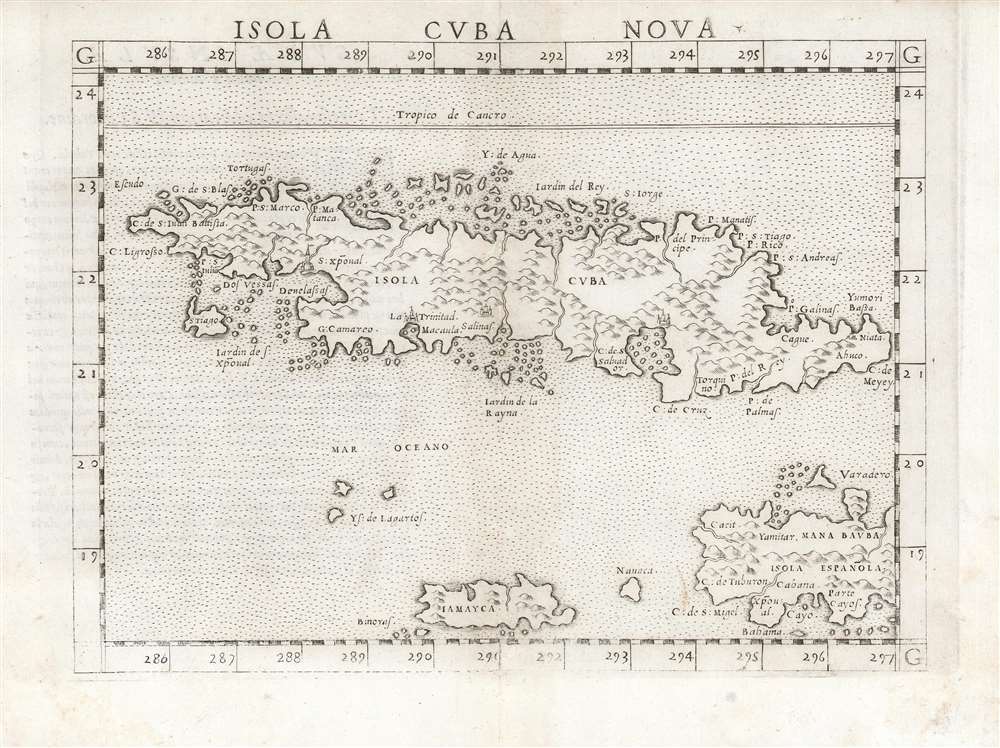1561 Ruscelli Map of Cuba, Jamaica, the Caymans and Haiti
Cuba-ruscelli-1561
Title
1561 (undated) 7.5 x 9.75 in (19.05 x 24.765 cm) 1 : 6000000
Description
A Closer Look
Although it is preceded by and based upon the very rare 1548 Gastaldi map of the same title, it is a superior engraving: larger, with sharper engraving and lettering. Also, Ruscelli's decision to use stippling in the ocean rather than the waves characterizing the Gastaldi resulted in a vastly more legible map.The Content
Ruscelli's map, in terms of the islands shown and place names used, is faithful to its 1548 source - although the spelling is improved upon the original (Gastaldi’s Iamayea is corrected to Iamayca, for example.) Cuba is shown with an array of named capes and points, including the southern archipelagos of the Jardines de la Reyna and the Jardines of St. Christopher (spelled using the fascinating contraction 'Xpoval' for 'Christobal'). Havana is not named: it would not appear on a map until 1579. Settlements are shown instead at San Cristobal, Trinidad, Salinas, and an unnamed site in the vicinity of Angostura. The absence of settlements on the north coast may reflect the early Spanish efforts to settle the island, which were largely launched from Hispaniola, rather than from the north.The Cayman Islands appear - not named 'Las Tortugas' as Columbus dubbed them, but Ys(las) de Lagartos (Lizard Islands).
Publication History and Census
This map was engraved for the 1561 first Ruscelli edition of Claudius Ptolemy'sLa Geografia di Claudio Tolomeo. The maps of this work were engraved two-to-a-plate, and consequently the platemark runs off the edge of the sheet at top, and this characterizes the maps of the Latin-text editions of 1562 and 1564 as well. For the 1574 edition the plates were cut, and maps of this edition and later exhibit a platemark all the way around. The present example corresponds to the Latin 1562 edition, both in terms of the first state of the map and the typography of the verso. In various editions there are six separate examples of this map listed in OCLC. Ruscelli's Ptolemy is well represented in institutional collections.CartographerS
Girolamo Ruscelli (1500 - 1566) was an Italian polymath, humanist, editor, and cartographer active in Venice during the early 16th century. Born in Viterbo, Ruscelli lived in Aquileia, Padua, Rome and Naples before relocating to Venice, where he spent much of his life. Cartographically, Ruscelli is best known for his important revision of Ptolemy's Geographia, which was published posthumously in 1574. Ruscelli, basing his work on Gastaldi's 1548 expansion of Ptolemy, added some 37 new "Ptolemaic" maps to his Italian translation of the Geographia. Ruscelli is also listed as the editor to such important works as Boccaccio's Decameron, Petrarch's verse, Ariosto's Orlando Furioso, and various other works. In addition to his well-known cartographic work many scholars associate Ruscelli with Alexius Pedemontanus, author of the popular De' Secreti del R. D. Alessio Piemontese. This well-known work, or "Book of Secrets" was a compilation of scientific and quasi-scientific medical recipes, household advice, and technical commentary on a range of topics that included metallurgy, alchemy, dyeing, perfume making. Ruscelli, as Alexius, founded a "Academy of Secrets," a group of noblemen and humanists dedicated to unearthing "forbidden" scientific knowledge. This was the first known experimental scientific society and was later imitated by a number of other groups throughout Europe, including the Accademia dei Secreti of Naples. More by this mapmaker...
Giacomo Gastaldi (c. 1500 - October, 1566) was an Italian astronomer, cartographer, and engineer active in the second half of the 16th century. Gastaldi (sometimes referred to as Jacopo or Iacobo) began his career as an engineer, serving the Venetian Republic in that capacity until the fourth decade of the sixteenth century. During this time he traveled extensively, building a large library relating to voyages and exploration. From about 1544 he turned his attention to mapmaking, working extensively with Gextantiovanni Battista Ramusio, Nicolo Bascarini, and Giovanbattista Pedrezano, as well as taking private commissions for, among others, Venice's Council of Ten. He is credited with the fresco maps of Asia and Africa still extant in the map room of the Doge's Palace. Gastaldi was also one of the first cartographers to embrace copper plate over woodblock engraving, marking an important development in the history of cartography. His 1548 edition of Ptolemy's Geographia was the first to be printed in a vernacular; it was the first to be printed in copperplate. As with his Swiss/German contemporary Münster, Gastaldi's work contained many maps depicting newly discovered regions for the first time, including the first map to focus on the East Coast of North America, and the first modern map of the Indian Peninsula. His works provided the source for the vast majority of the Venetian and Roman map publishers of the 1560s and 70s, and would continue to provide an outsize influence on the early maps of Ortelius, De Jode, and Mercator. Learn More...
Source
- 1561 La Geographia di Claudio Tolomeo Alessandrino, Italian. Venice, Vincenzo Valgrisi.
- 1562 Geographia Cl. Ptolemaei Alexandrini, Latin. Venice, Vincenzo Valgrisi.
- 1564 La Geographia di Claudio Tolomeo Alessandrino, Italian. Venice, Giordano Ziletti.
- 1564 Geographia Cl. Ptolemaei Alexandrini, Latin. Venice, Giordano Ziletti.
- 1574 La Geographia di Claudio Tolomeo Alessandrino, Italian. Venice, Giordano Ziletti.
- 1598 Geographia di Claudio Tolomeo Alessandrino, Italian. Venice, heirs of Melchoir Sessa.
- 1599 Geographia di Claudio Tolomeo Alessandrino, Italian. Venice, heirs of Melchoir Sessa.

